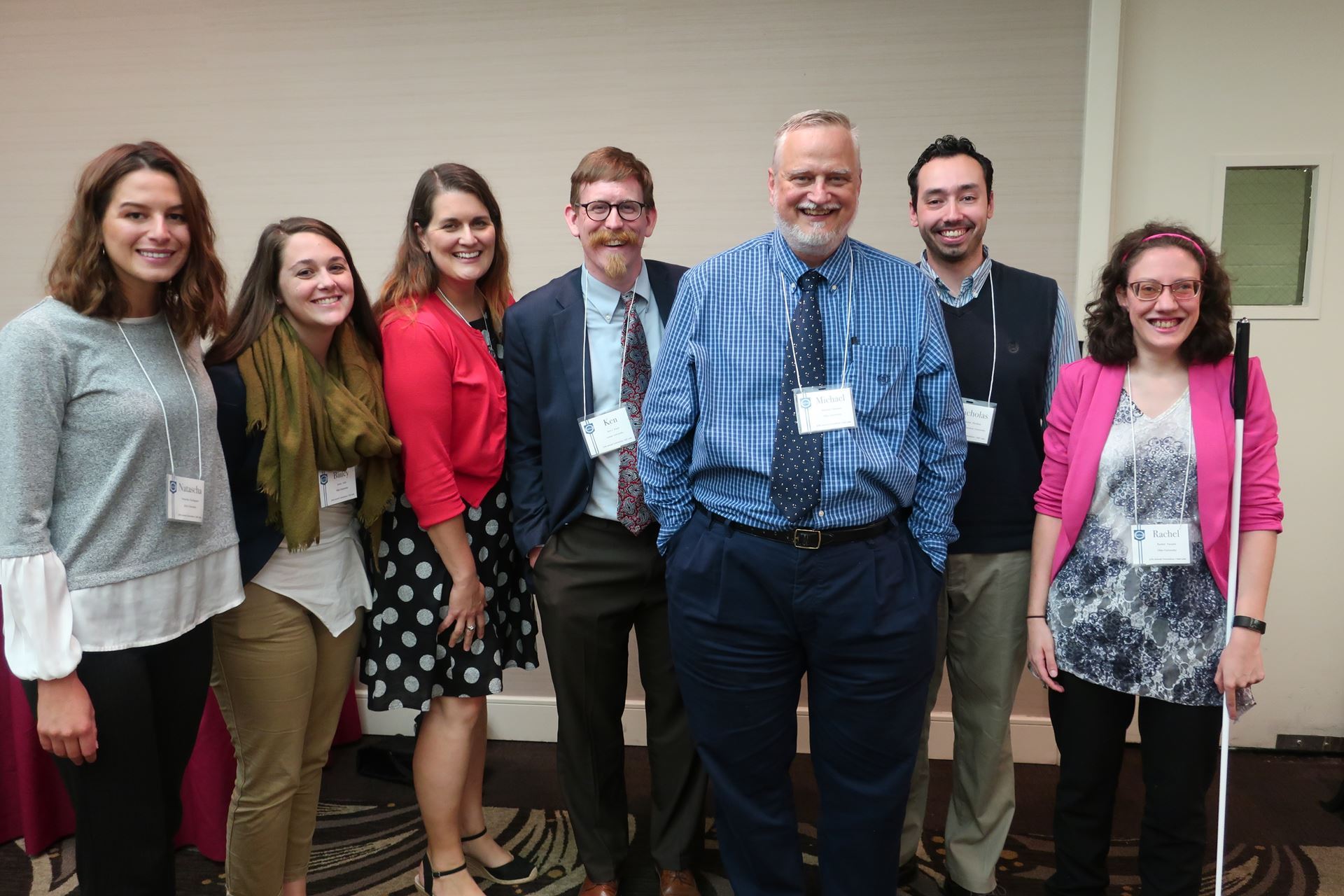 Mike Sweeney (third from the right) with current and former Ohio University graduate students at the 2018 AJHA conference, where Sweeney received the National Award for Excellence in Teaching.
Mike Sweeney (third from the right) with current and former Ohio University graduate students at the 2018 AJHA conference, where Sweeney received the National Award for Excellence in Teaching.
by Erika Pribanic-Smith, AJHA Executive Director and Interim Intelligencer Editor
Over the past 38 years, an Ohio University graduate seminar has been responsible for bringing dozens of students to AJHA—many of whom have become faculty members and brought their own students to the conference.
Pat Washburn developed the historical research class and taught it for the entire time that he was at Ohio University (1984-2012). He said he modeled the course after a seminar he took with David Nord as a doctoral student at Indiana University.
Washburn incorporated lessons he learned from reading papers presented at conferences and listening carefully to the critiques of the papers.
“After doing that for three years, I basically knew what errors to avoid,” Washburn said. “As a result, throughout my entire academic career, I only had one paper rejected at a meeting.”
To help his graduate students learn how to do--and write--historical research successfully, Washburn required them to read three historical papers that had been given at conferences for every class meeting. He carefully chose papers that had flaws so the class could discuss them and learn what not to do.
Washburn also required his students to conduct their own historical research using primary and secondary sources. At the end of the course, students would get one of their peers’ papers by blind draw to critique. Ultimately, all but 10 percent of the course grade was based on the research paper and peer critique.
“The success of the class was shown by the fact that from 1985 to 2012, 91 papers from the class were given at academic meetings (mostly AEJMC and AJHA), and 24 became journal articles,” Washburn said. “I was proud of those numbers.”
A former student of Washburn’s, Mike Sweeney picked up the course in 2012 and continued the success Washburn had. Sweeney's driving philosophy was that historiography is easy and fun. Convincing students of this meant ensuring their success in the class, he said.
Sweeney reduced the weight of the research paper to 60 percent of the course grade so he would not “‘freak out’ students by having the final paper count overmuch.” Furthermore, it was important to Sweeney that students receive feedback early in the course, particularly on Chicago Style. Therefore, a five-page paper worth 100 points (10 percent of the final grade) was due about three weeks into the term. This gave students the opportunity to see how Sweeney marked papers.
The assignment involved looking for examples of the inverted pyramid in primary documents: news stories from 1865, 1875, 1885, and 1895 that students could view in hard copy at libraries or electronically using resources such as newspapers.com. Sweeney chose that time frame because the start of the inverted pyramid generally is said to be the wire story of the telegram Secretary of War Edwin Stanton sent to the commanding general in New York City regarding the assassination of Abraham Lincoln. By giving students this assignment, rather than immediately cutting them loose to research anything in any period, Sweeney helped students learn the importance of selecting a research timeline and a rationale for that timeline.
Like Washburn, Sweeney felt it was important to give students an understanding of what historiography is. They would learn this from reading how to do it, reading professional examples of it (including Sweeney’s own work), and getting feedback on their own research from him and their classmates. He adopted Washburn’s assignment of critiquing a peer’s research paper selected by blind draw, and he added a short paper critiquing an anonymous research paper that Sweeney selected.
Ultimately, Sweeney aimed to ensure that students produced a publishable, high-quality academic research paper about a mass communication history topic. Sweeney specifically wanted students to produce a paper that they could present at AJHA or AEJMC, which he relayed to them at the outset of the course. His goal in getting students published was to show them how easy it is to keep on publishing because teaching is, as he told them, a “good gig.”
Sweeney said his students “blew out the field” in terms of published papers. In one year, he noted, seven grad students from the program at Ohio presented a paper or research in progress at the AJHA conference.
AJHA President Aimee Edmondson now is the lone historian in the E.W. Scripps School of Journalism after the retirements of Washburn and Sweeney as well as fellow AJHA members Joe Bernt, Ellen Gerl, and Marilyn Greenwald. Edmondson will be teaching the historical methods course, which is open both to master’s and doctoral students.
She said she would maintain the focus on students producing publishable research papers. Her updates would include incorporating more of how historians use theory. Edmondson aims to “break down the silos” by showing how scholars use other disciplines to study history, including critical cultural studies, social history, environmental communication, law, political science, and African American studies.
“I think that would be the way I would do it, while keeping the best of what Mike and Pat did,” she said.
Edmondson routinely teaches the undergrad history course. The primary difference is that the undergraduate class involves lecturing to students on history topics whereas the graduate class involves students learning history through the process of learning how to do history.
Furthermore, the undergraduate course is about six times larger than the graduate seminar. The smaller size of the seminar allows for individual coaching.
"There's a lot of working with students one-on-one to help them come up with a topic and then how to best approach it," Edmondson said.

